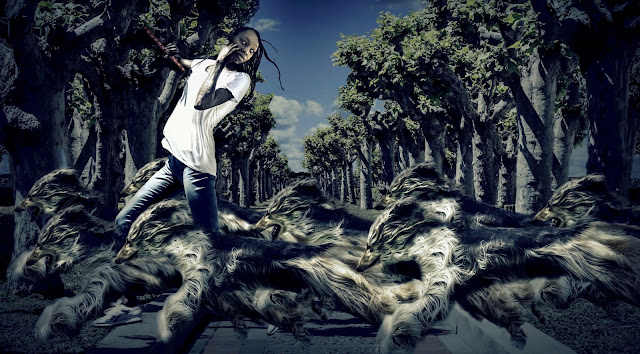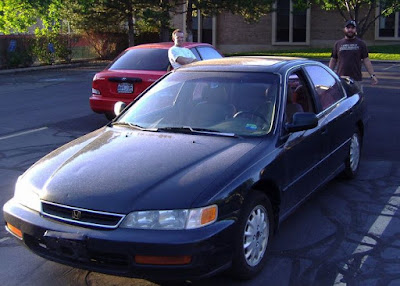Photography: Narrative Photography vs Istoria (and shadows)
San Francisco, California
My narrative
All I wanted to say on this blog was that I will be exploring shadows on my photography. But when I started writing the post, somehow, it became a complex lecture about photography. LOL
I started the post with this sentence: "I've been experimenting with a sort of fusion of 'narrative photography' and painting's 'istoria.' Which are basically the same thing but from different outlets (mediums.)" And everything went downhill from there.
But lets start with my approach on this topic:
This picture.
Long story short, I saw this picture, and I fell in loved with it. (I wish I could find a better resolution of it, but oh well... here's is the source)
If it was a painting:
That picture is so perfect to me. So poetic and romantic, and average. It says a lot about nothing. It sparks the imagination and the wonder. If the photograph was orchestrated by a Renascence painter and every object had a reason, or a meaning, these would be my guess for them all:
There are six or seven characters, or objects, on this image.
Ok... that's it... you can skip the next part if you are already bored. If you want to know more, read on.
Photographic istoria (The lecture part)
I've been experimenting with what a fusion of "narrative photography" and painting's "istoria." Which is basically the same thing, but from different outlets (mediums.)
Istoria comes from a Latin word that means Narrative. During the 15th century (Italian renaissance) painters started to paint complex new narrative and allegorical subjects on their work to tell a whole story on one paint. Author, Leon Battista Alberti, on his book, De pictura (1435), said that 'istoria' is "the most ambitious and most difficult category of works a painter can attempt."
Narrative photography is also complex and is still debated today as if it's possible to fully achieve. The idea is that photographs can be used to tell a story, however, because photography captures single discreet moments, and narrative, as described by Jerome Bruner, is irreducibly temporal, there is doubt that photography can actually represent narrative structure.

Narrative structure is about two things: The story and the plot, the content of a story and the form used to tell the story.
Story refers to the raw materials of dramatic action as they might be described in chronological order.
Plot refers to how the story is told — the form of storytelling, or the structure, that the story follows. (If we want to analyze narrative structure, we can use “who,” “what,” and “where” questions to look at the story or content of a narration. “How” and “when” questions are used to examine plot structure.)
The following is a sample of Narrative Photography by Alain Laboile. This picture tells part of a story of a whole, that one can find here.

The Narrative Photography Competition in Portland, Oregon, describes the concept in the following way: "The power of narrative, or story telling is at the foundation of much of photography. Photograhers are creating complex and descriptive moments in time. Contemporary photographers are crafting and documenting new forms of a visual short story."
Samples of photographs using shadows to tell a story: (I don't have the sources of any of them, sorry)
My narrative
All I wanted to say on this blog was that I will be exploring shadows on my photography. But when I started writing the post, somehow, it became a complex lecture about photography. LOL
I started the post with this sentence: "I've been experimenting with a sort of fusion of 'narrative photography' and painting's 'istoria.' Which are basically the same thing but from different outlets (mediums.)" And everything went downhill from there.
But lets start with my approach on this topic:
This picture.
Long story short, I saw this picture, and I fell in loved with it. (I wish I could find a better resolution of it, but oh well... here's is the source)
If it was a painting:
That picture is so perfect to me. So poetic and romantic, and average. It says a lot about nothing. It sparks the imagination and the wonder. If the photograph was orchestrated by a Renascence painter and every object had a reason, or a meaning, these would be my guess for them all:
There are six or seven characters, or objects, on this image.
- The man almost out of the frame: This could be a whole symbol of mundane. Ordinary people, us, who pass by millions of possible stories every day. He is almost out of the frame, he is not important, but important enough to be on the frame.
- The girl: She's also heading to be out of the frame. She's almost not important, yet she's the key to the story.
- The man looking at the girl: This story is about him. I can't put into words what his look could mean, and yet there are so many possibilities. He looks like as if he has a mini-second of instant molecular connection with that girl. As if he was just walking by and the universe spoke to him... "talk to her," the universe said. It talked to her as well. She didn't hear it one can only assume, since she kept walking. But he didn't ignore the universe, at least for a half of a second. He heard something, he looked; but he kept walking. We can guess by our own experience, that nothing is going to happen here. Basically, we know the end of the story. but the author gave us three other characters that tell a different story, a possibility.
- The shadowed-man and shadowed-girl about to kiss. They know, they have been waiting to meet, and they listened to the universe.
- The dog. the witness of it all. (We can add the pigeon standing on the wall as the seventh character here, but he is only witnessing one side of the story. he does not have the whole picture like me and you, or the dog.)
Ok... that's it... you can skip the next part if you are already bored. If you want to know more, read on.
Photographic istoria (The lecture part)
I've been experimenting with what a fusion of "narrative photography" and painting's "istoria." Which is basically the same thing, but from different outlets (mediums.)
 |
| The Death of Socrates is an oil on canvas painted by French painter Jacques- |
Istoria comes from a Latin word that means Narrative. During the 15th century (Italian renaissance) painters started to paint complex new narrative and allegorical subjects on their work to tell a whole story on one paint. Author, Leon Battista Alberti, on his book, De pictura (1435), said that 'istoria' is "the most ambitious and most difficult category of works a painter can attempt."
Narrative photography is also complex and is still debated today as if it's possible to fully achieve. The idea is that photographs can be used to tell a story, however, because photography captures single discreet moments, and narrative, as described by Jerome Bruner, is irreducibly temporal, there is doubt that photography can actually represent narrative structure.

Narrative structure is about two things: The story and the plot, the content of a story and the form used to tell the story.
Story refers to the raw materials of dramatic action as they might be described in chronological order.
Plot refers to how the story is told — the form of storytelling, or the structure, that the story follows. (If we want to analyze narrative structure, we can use “who,” “what,” and “where” questions to look at the story or content of a narration. “How” and “when” questions are used to examine plot structure.)
The following is a sample of Narrative Photography by Alain Laboile. This picture tells part of a story of a whole, that one can find here.

The Narrative Photography Competition in Portland, Oregon, describes the concept in the following way: "The power of narrative, or story telling is at the foundation of much of photography. Photograhers are creating complex and descriptive moments in time. Contemporary photographers are crafting and documenting new forms of a visual short story."
Samples of photographs using shadows to tell a story: (I don't have the sources of any of them, sorry)





















